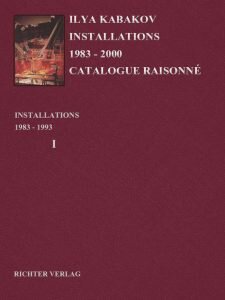The Unhung Painting
YEAR: 1992
CATALOGUE NUMBER: 64
PROVENANCE
Using the diptych Abramtsevo from 1982 and 30 drawings from 1992
1992, Collection Museum Ludwig, Cologne
DESCRIPTION
In some dilapidated Soviet organization, they are getting ready to hang a painting on the wall. They have placed this painting, drawn on two large boards, on three chairs, but for some reason, it hasn’t been hung up. Most likely, it was lunchtime, or something else distracted the people who were supposed to begin and finish the job.
Instruments for the job lie ready on the floor: a hammer, pliers, nails scattered about, screws. There is a stepladder in the corner near the painting.
But apparently, no one has come to do the job for a long time, and perhaps no one will come. In any case, this ‘abandoned’ endeavor annoys those who observe it – no one can pass by quietly, without saying something about this.
These utterances are written down, forming a series of textual sketches (approximately 30 of them) that are hung in frames in a single row on the three empty walls of the room.
What does the actual dwelling look like? The walls and ceiling are painted gray. The lower part of the walls is covered with a dark reddish brown paint. The floor is also reddish-brown, and the half-opened door is the same color … And everything is submerged in semi-darkness from the dull light of two dusty light bulbs, without lamp-shades, that are hanging from electrical cords.
CONCEPT OF THE INSTALLATION
I have always been attracted to the problem of the ‘ready – not ready.’ It may be easy to distinguish in everyday life between a ‘ready table’ and one that is still being prepared, and the ‘ready’ main course from the ‘not ready’ one, but this is not so obvious in the so-called art of the modern. In contradistinction to old art, where the completion of the painting is programmed from the very beginning, in the paintings of the Impressionists and the Fauvists, in the collages of Schwitters, in works of the ‘Fluxus’ movement, this becomes not so clear. The borders between ‘the finished and the unfinished’ turn out to be blurred, and a knowledge of special conditions and circumstances is required of the viewer for him to be certain that what is before him is a ‘finished’ work of art.
This problem achieves great uncertainty in the installation, especially in that genre which can be called the ‘total installation’ (which includes numerous elements of ordinary, everyday reality), or in the other genre of the ‘open installation’ (in which the surrounding, actual space of life is included ‘on an equal footing’ and it is impossible to draw the border between this real space and ‘artistic’ space).
This problem attracts me for yet another reason: a certain gap arises between the beginning of a work and its ‘non-end,’ the duration of which is filled with specific questions, assumptions, thoughts. The ‘effect of anticipation’ that arises along with this turns out to be very productive, provoking a certain internal activity on behalf of the viewer, who must explain for himself the reason for the ‘delay’ in anticipating the ‘end of the thing.’
Therefore, the space where tension between the ‘finished – unfinished’ arises, turns out not to be empty, but rather full of these fantasies, explanations, and anticipations.
Of course, in order for such an idea to emerge, one must possess a similar life experience, where a similar tension between two poles arises. In our Soviet reality, there is more than enough of such experiences. You don’t need to go far to find an example: all you need to do is glance out the window. Opposite is a building which was under construction for 14 years (!), and how many years has it stood abandoned! It has long ago been reduced to ruins, everything that could be, has already been stolen and carried away. The name ‘construction site – garbage dump’ is very appropriate for it. To the external eye, it is impossible to tell whether this is a building under construction or one that is ‘disappearing’ or, in general, what was the intention of the authors and builders of the project.
This experience, this problem, always leads me to the idea of constructing a ‘not-ready installation.’ The installation The Unhung Painting could be viewed as one possible version of this idea.
Images
Literature





